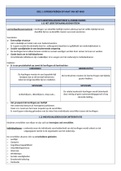Tentamen (uitwerkingen)
Study questions for the exam of Work & Performance - Master SHOP
- Instelling
- Universiteit Utrecht (UU)
All exam questions 2022 with answers. Articles: 1. Schaufeli & Taris (2014) 2. De Jonge, Spoor, Sonnentag, Dormann & Van den Tooren (2012) 3. Grant & Parker (2009) 4. De Vos et al. (2020) 5. Nielsen & Randall (2013)
[Meer zien]













